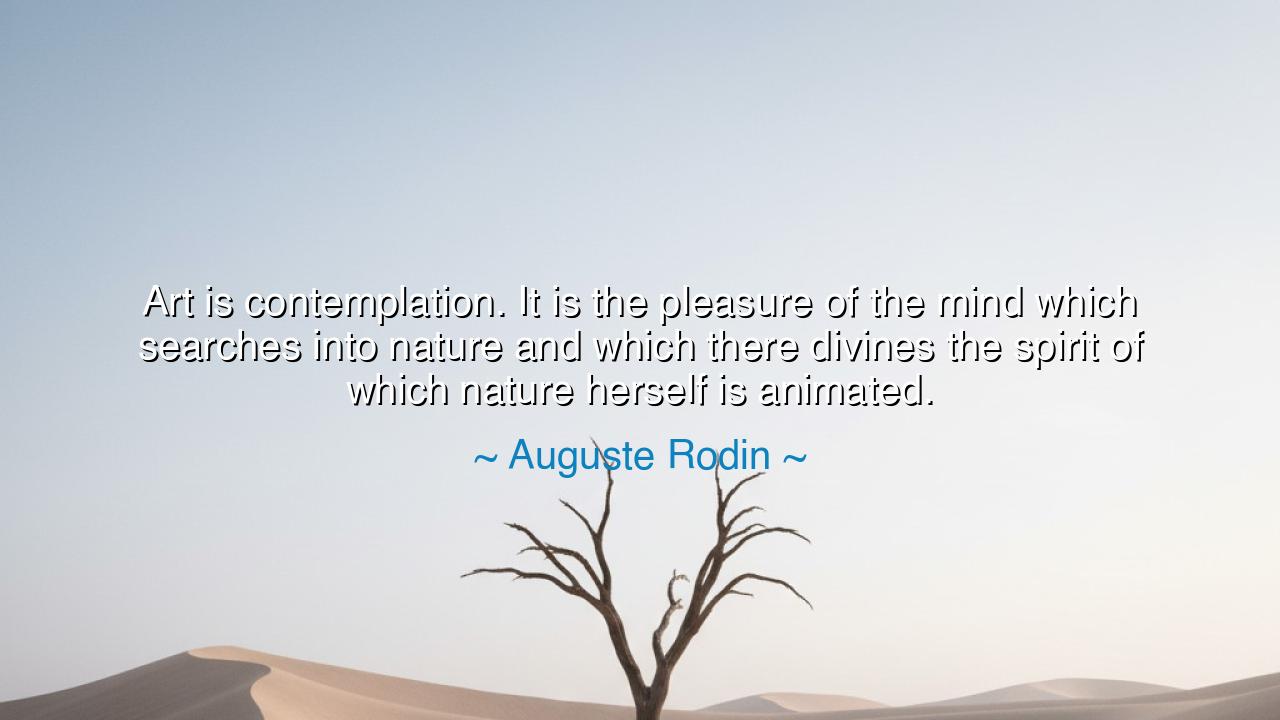
Art is contemplation. It is the pleasure of the mind which
Art is contemplation. It is the pleasure of the mind which searches into nature and which there divines the spirit of which nature herself is animated.






When Auguste Rodin declared, “Art is contemplation. It is the pleasure of the mind which searches into nature and which there divines the spirit of which nature herself is animated,” he unveiled the sacred marriage between creation and observation. In his words lies the truth that art is not merely craft, nor only the shaping of stone, canvas, or sound, but a profound act of contemplation. The artist does not seize nature with greedy hands, but gazes into her depths with the stillness of one who listens. And in that listening, the mind discovers the spirit that breathes within all living things, the pulse that animates the universe itself.
Rodin himself knew this truth intimately. As a sculptor, he studied the human body not as lifeless form but as a vessel of movement and soul. His statues—The Thinker, The Kiss—do not sit as cold marble, but seem alive, caught in the eternal breath between thought and action. This was not achieved by imitation alone, but by searching into nature with patience, by divining the hidden fire that gives flesh its vitality. To Rodin, the artist’s eye is a seer’s eye: it looks beyond the visible into the invisible essence that stirs within.
The ancients understood this, too. The Greek philosopher Plato taught that the things of this world are shadows of eternal forms, and that true beauty lies not merely in what is seen, but in what is reflected beyond sight. In this way, the artist becomes like the philosopher: both seek to pierce the veil, both hunger to touch the spirit that lies behind the surface. Thus, Rodin’s words echo the wisdom of ages past—that art is not a shallow pleasure, but a sacred inquiry into the soul of nature.
We see this also in the life of Leonardo da Vinci. His notebooks overflow not only with sketches of human anatomy, but with studies of rivers, birds, and machines. Why? Because he believed that to create art one must first contemplate nature. His paintings endure not because of technical brilliance alone, but because they hum with the spirit of life itself. In the Mona Lisa’s smile, there is the quiet mystery of the world; in The Last Supper, the weight of eternity pressing upon a single moment. Leonardo divined what Rodin would later articulate: that the artist’s mind, in contemplating nature, uncovers the divine breath within it.
From Rodin’s teaching we learn that true artistry, whether in stone, song, or word, requires more than skill. It demands silence, patience, and reverence. The artist must dwell with nature, not rushing to capture her but waiting until her inner voice is heard. Only then does art transcend mere form and become revelation. To contemplate is to honor, and to honor is to allow the soul of creation to shine through the work.
The lesson for us, seekers of wisdom and makers of things, is this: cultivate the art of contemplation. When you walk in the forest, do not hurry; let your eyes rest upon the leaf until you feel the life within it. When you labor at your craft, do not force creation from restless hands; let it rise from stillness, from seeing truly. And when you look at others, at friends, at strangers, at loved ones, do not stop at surface and form—search for the spirit that animates them, the spark of nature’s divine flame.
Practically, you may begin by setting aside moments of quiet observation each day. Study the way light touches water, the way wind bends the grass, the way a face carries both sorrow and joy. Keep a journal, a sketch, or a melody born of these contemplations. In doing so, you train the mind not only to see, but to divine. And from this divination, true art—whether humble or grand—will emerge.
Thus, Rodin’s words call to us across time: art is contemplation, and through contemplation, we discover that nature is not mute but alive, animated by a spirit waiting to be unveiled. Let us, then, live as artists in all things, searching with reverence, creating with wonder, and allowing the soul of nature to speak through our works and through our lives.






AAdministratorAdministrator
Welcome, honored guests. Please leave a comment, we will respond soon